TPC Pt and DCA resolution
[Update on 2010-06-21: global track momentum resolution has now also been studied using Cosmic rays study, version 2, with some as yet unexplained good performance at very high pT.]
_____________
Jim Thomas has written code to model transverse momentum (pT) and pointing resolution near the primary vertex (DCA) of tracks using various detectors. The code has been tuned to match TPC performance under low luminosity conditions, but assumes (for simplicity) TPC hit errors of 0.06 cm in rφ and 0.15 cm in z (which can be compared with the TPC Hit Errors (2008)), throwing tracks at η = 0.5 and including hits in "nearly all" 45 padrows (padrows 1 and 13 are dropped).
Shown below are the pt resolutions for various options:
- Black filled triangles: embedded antiprotons at half field
- Black open triangles: embedded pions at half field
- Cyan: model prediction for global (anti)proton tracks at half field
- Green: model prediction for global pion tracks at half field
- Blue: model prediction for global pion tracks at full field
- Red: model prediction for primary pion tracks at full field (primary vertex known to 1 mm)
- Magenta: model prediction for primary pion tracks at full field (primary vertex known to 0.3 mm)
.gif)
Note that the embedding data was shown in Figure 10 of the TPC NIM paper [1]. At low pT, the resolution is dominated by multiple coulomb scattering (MCS) effects. At high pT, the momentum resolution approaches a C * pT2 dependence (note that C can be considered the inverse transverse momentum resolution, as δ(1/pT) = δ(pT) / pT2 for small δ(pT)). For the above curves, C (in units of inverse momentum [c/GeV]) is approximately:
- Cyan and Green: 0.018
- Blue: 0.009
- Red: 0.005
- Magenta: 0.003
Here is the same model run with only using every other padrow of the TPC:
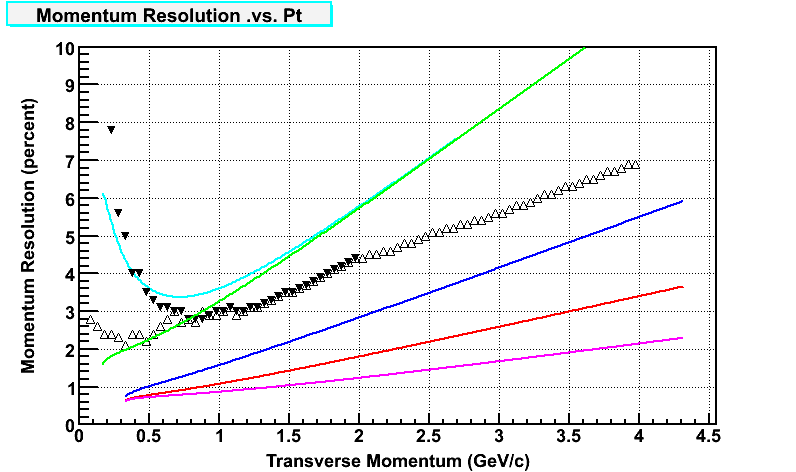
For the above "less hits" curves, C is approximately 50% higher in all cases:
- Cyan and Green: 0.027
- Blue: 0.013
- Red: 0.008
- Magenta: 0.0045
Additional studies of the momentum resolution come from Yuri Fisyak for Monte Carlo simulations (similar to a thorough embedding study done using TPT in 2002 by Jen Klay) in the following plots for globals and primaries in AuAu200 and pp500 [with pileup] collisions. The comparison is best made with the blue [AuAu globals] and magenta [AuAu primaries] lines above. The data matches reasonably well with the "less hits" model curves, with the exception of an additional offset of about 0.5% for global tracks. The pileup in the pp500 simulation probably causes its results for primaries to have even further degraded resolutions than the red [pp primaries] lines above.
AuAu200 [Run 10 FF setup]:
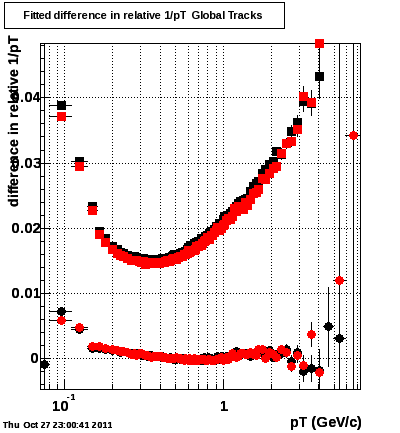
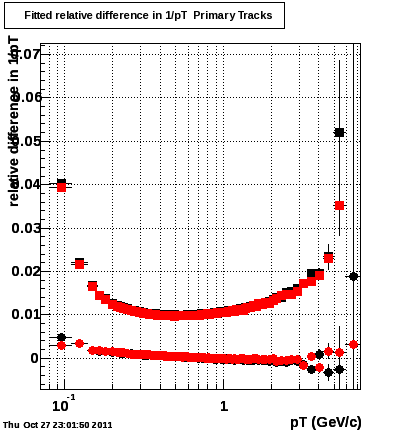
pp500 [Run 9 RFF setup, with pileup]:
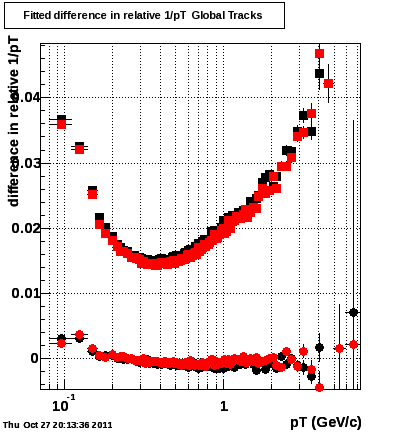
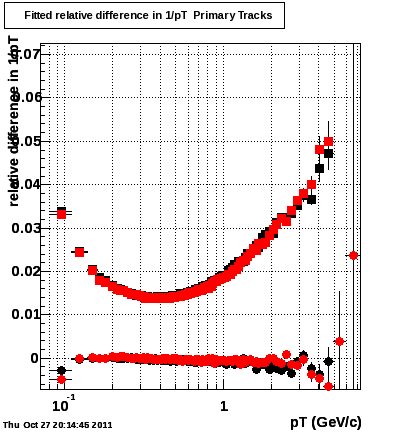
Shown below are the DCA resolutions from the same model described earlier, using tracks with "nearly all" hits, for
- Cyan: model prediction for global (anti)proton tracks at half field
- Green: model prediction for global pion tracks at half field
- Blue: model prediction for global pion tracks at full field
.gif)
[note: I do not know what the dashed lines are]
As can be seen, the field makes only a small impact on the DCA resolution. When using "good" (high quality) tracks for calibrations, I regularly find a mean DCA resolution for global tracks in full field of just under 3 mm.
EPS versions of these images are attached.
References:
1. M. Anderson et al., Nucl. Instr. and Meth. A499 (2003) 659-678
- Printer-friendly version
- Login or register to post comments
